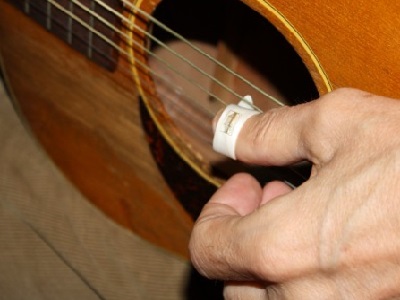How to Hold the Classical Guitar Correctly
 As musicians, we tend to look past the tiny technical detail and delve right in to the meat of things. While that is great in most cases, when it comes to proper form, it isn’t.
As musicians, we tend to look past the tiny technical detail and delve right in to the meat of things. While that is great in most cases, when it comes to proper form, it isn’t.
The worst thing I have seen fellow guitarists do is sacrifice form for performance. Many guitarists that I see will adopt lazy positions in holding the classical guitar just because they make playing easier.
While this is grand in the short run, in the long scheme of things this can lead to injuries that can put you out of playing for years, or worse; permanently. Holding your classical guitar correctly requires form. Just like any athlete, form is the key to success.
Are You Sitting Correctly?
First things to check off in learning how to hold a classical guitar properly is to check your posture. You want your spine to be completely erect, which will allow your body to use less strain for movements.
When you sit straight up to achieve proper posture, your shoulder blades should be drawn back slightly, and your chest should stand high and proud. If you feel discomfort in your lower back, simply straighten back up; this usually means that a small portion of your back has begun to slouch, putting stress on the straight areas. Your chin shouldn’t be resting against your chest; it should be parallel to the floor.
When you are sitting straight, you have won half the battle of holding the classical guitar. Before we even pick up our guitar, there is one more postural aspect to consider; your legs. If you are a right handed guitarist, your left leg should be raised. This is so that the body of your instrument leans against it, which in turn puts a slight angle on the guitar.
Use a Slight Elevation on Your Foot
If you are left handed, your right leg should be raised instead, and for the same reasons. Putting a slant on your guitar, with the neck rising upwards, eliminates strain on your fretting hand, wrist, and arm.
Not only this, it also makes fret access much easier. The less you have to stretch and maneuver, the quicker you can reach your desired notes and positioning.
When you finally pick up your guitar, you are three quarters of the way. At no point in classical guitar should your picking hand rest on the guitar itself. This means no thumb shelves, no palm rests, no finger bridging.
Your arm should curve around the guitar’s body, and your hand should rest above the strings, because unlike other forms of music such as rock and roll and blues, classical guitar involves absolutely no palm muting, and the mobility of your hand rests on the shoulders of your form. Resting any part of your hand limits mobility, thus making you note only slower, but sloppier as well.
Finally, your fretting hand. Your fretting hand’s thumb should never peak over the top of your fret board. Not only does this cause stress on the wrist as you must contort it to an unnatural angle, but it also leads to poor habits.
There should always be a centimeter between your palm and the back of the fret board. This not only allows free range of motion, but helps avoid white knuckling.
Once you have achieved proper classical guitar holding form be sure to keep your awareness. When you see faults in your form, simply correct them. This will help you to avoid learning bad habits.







Leave A Comment